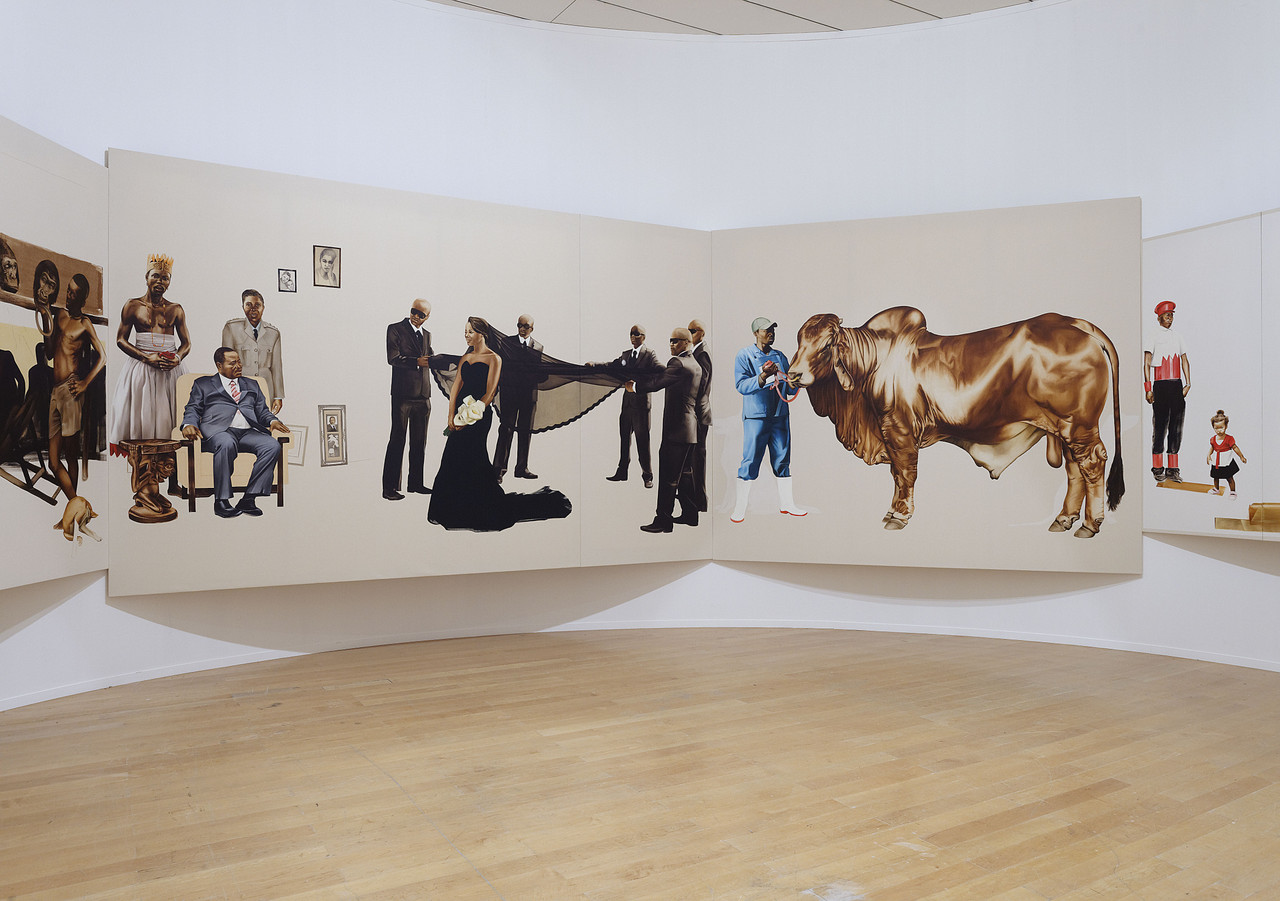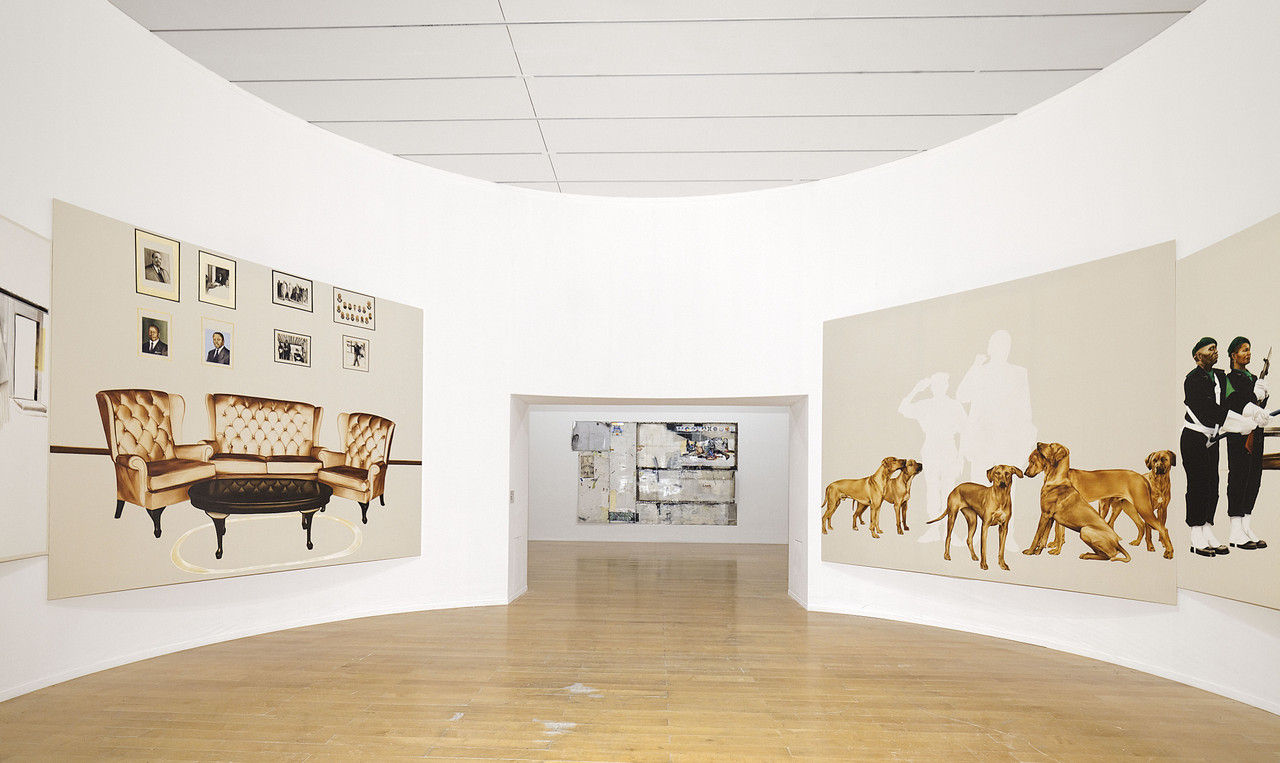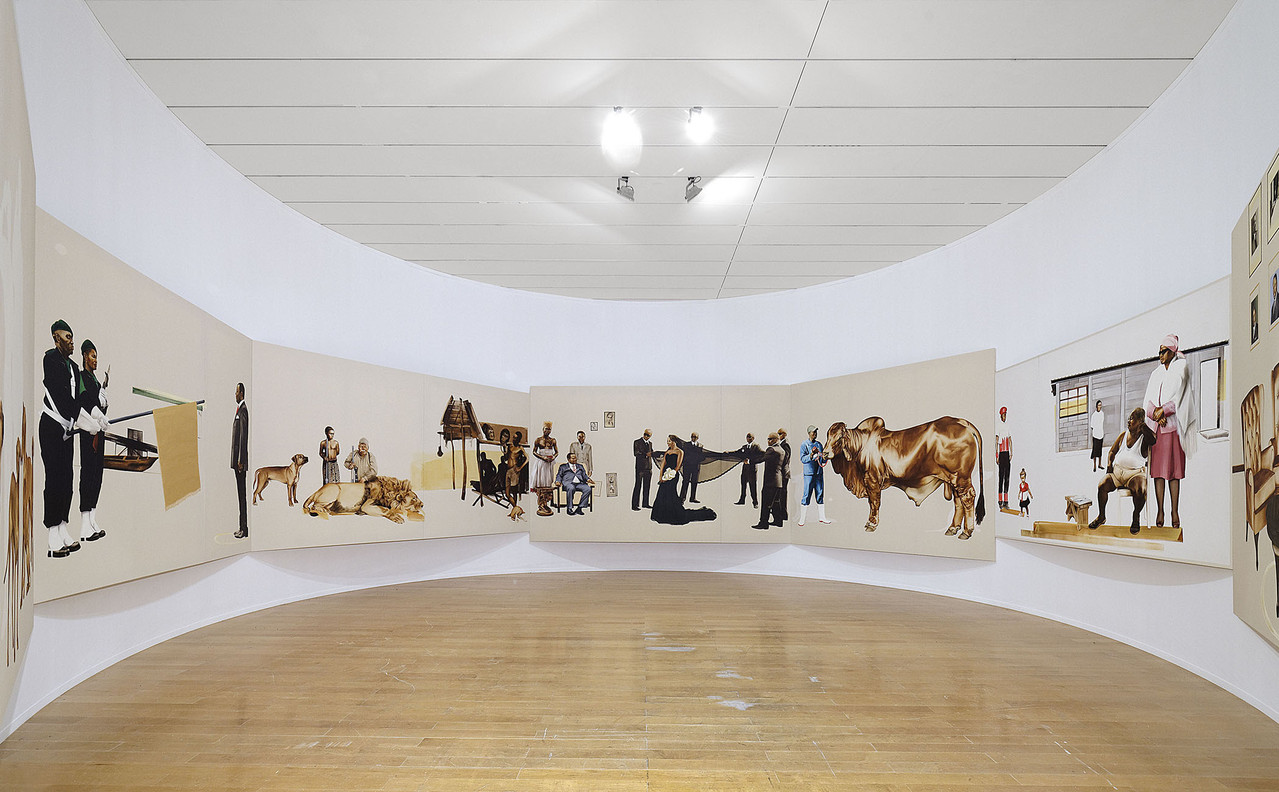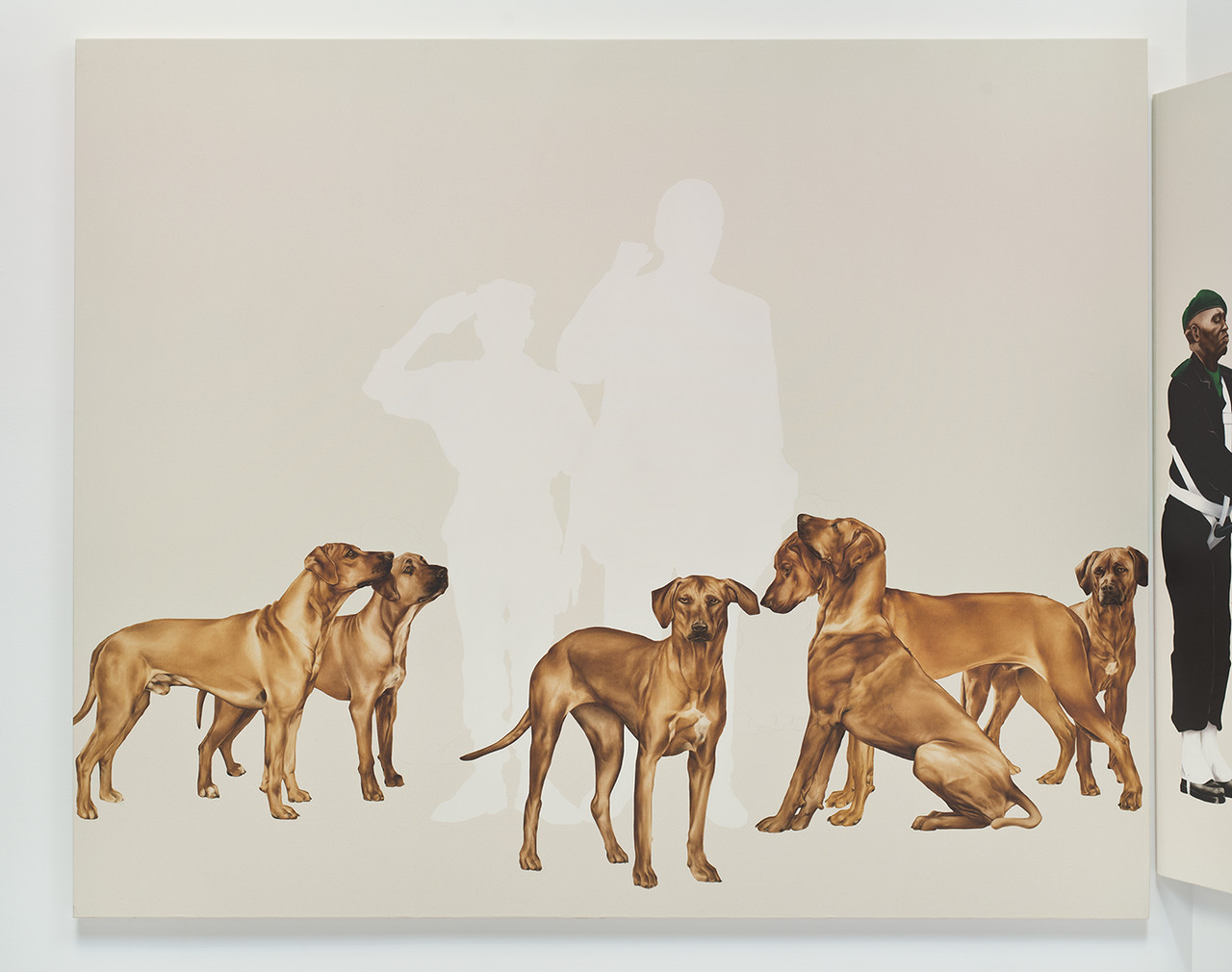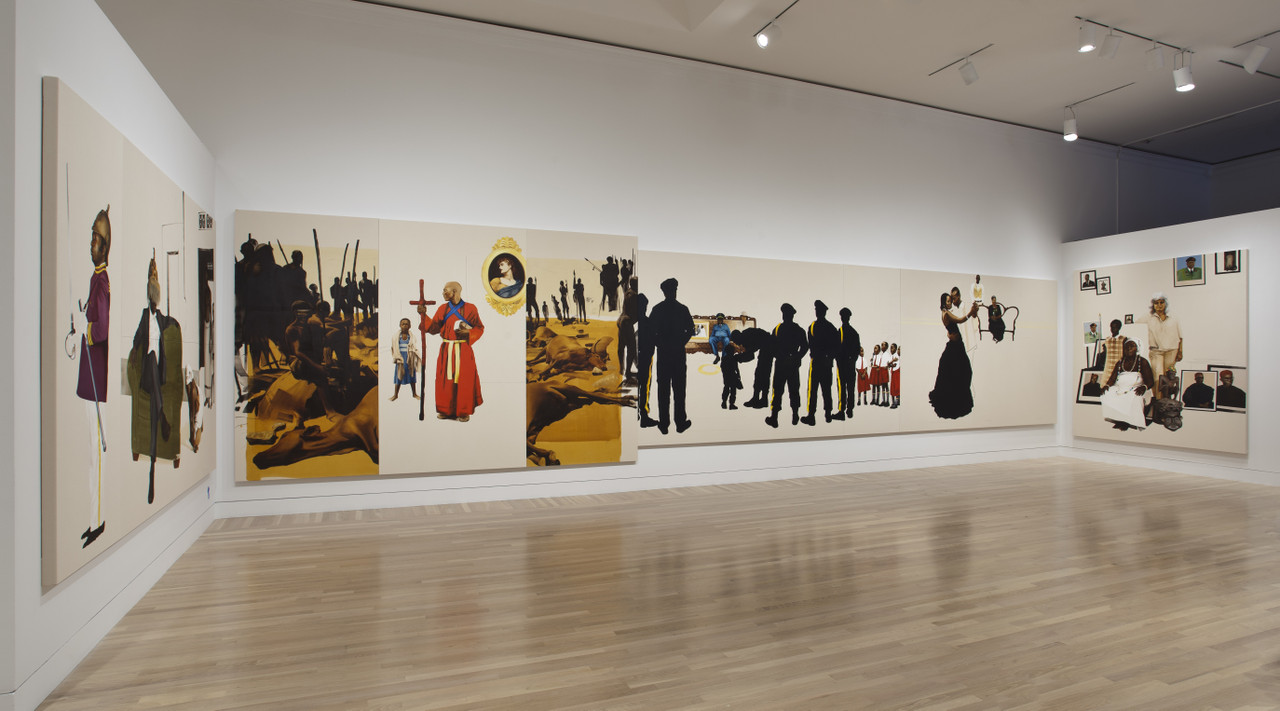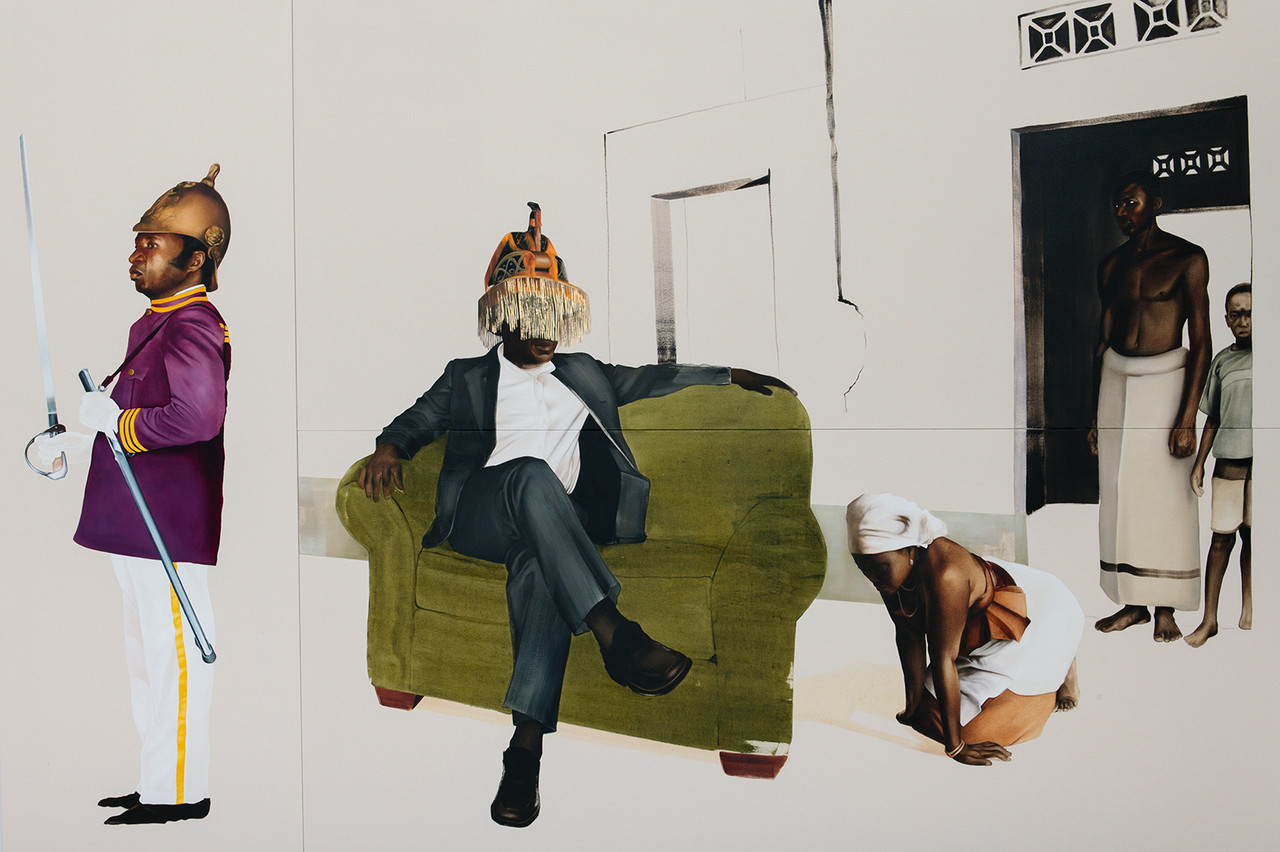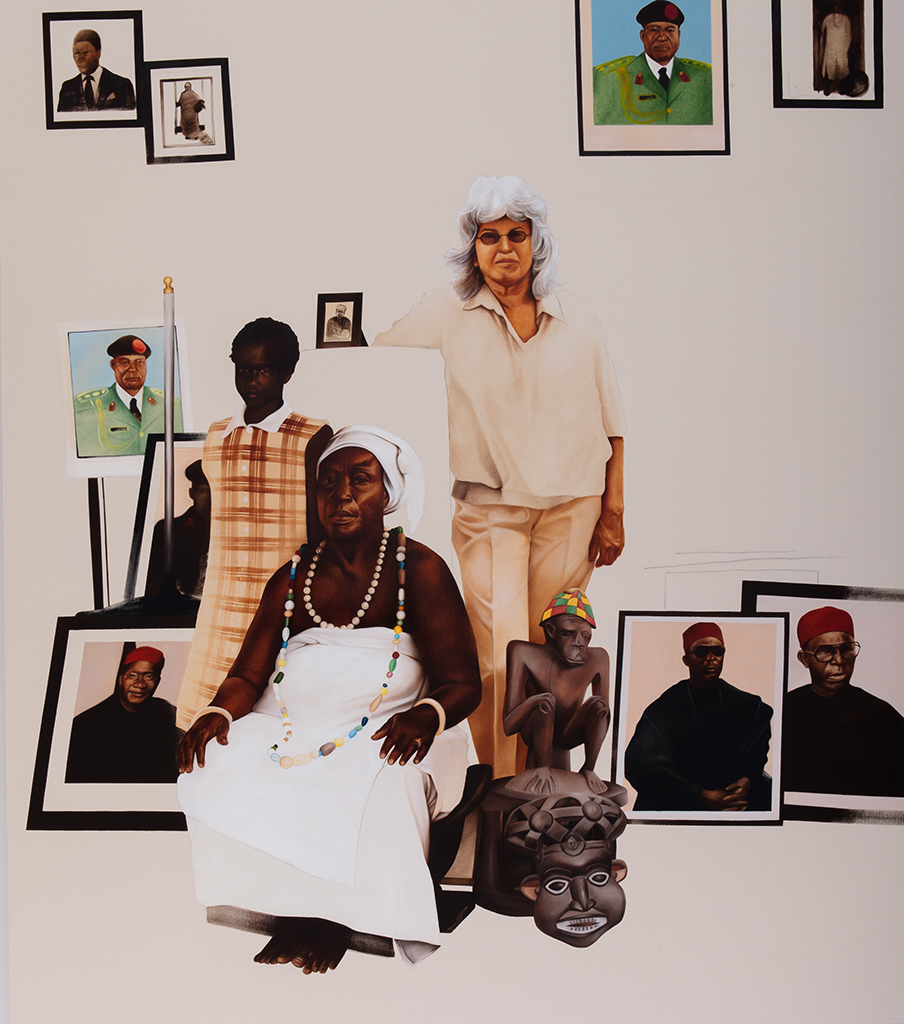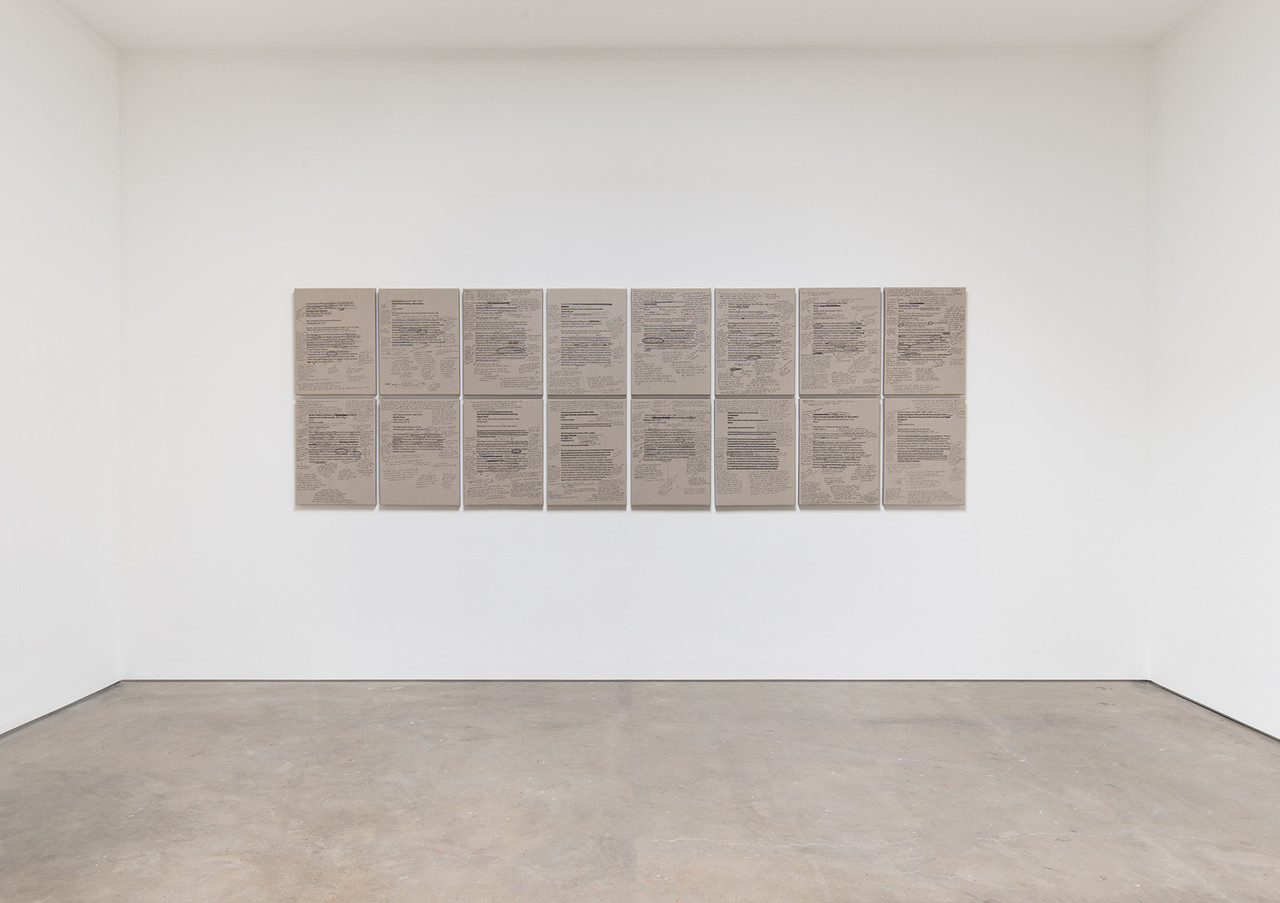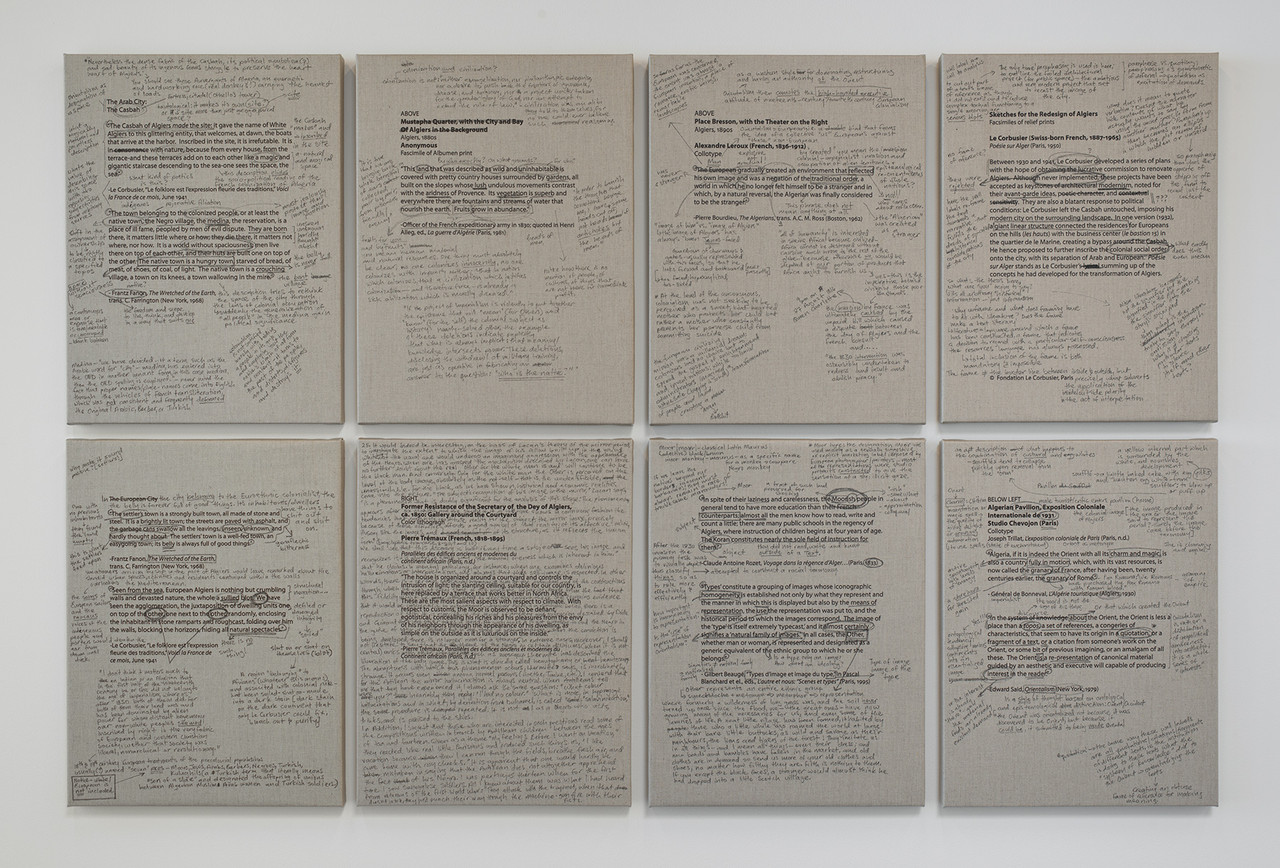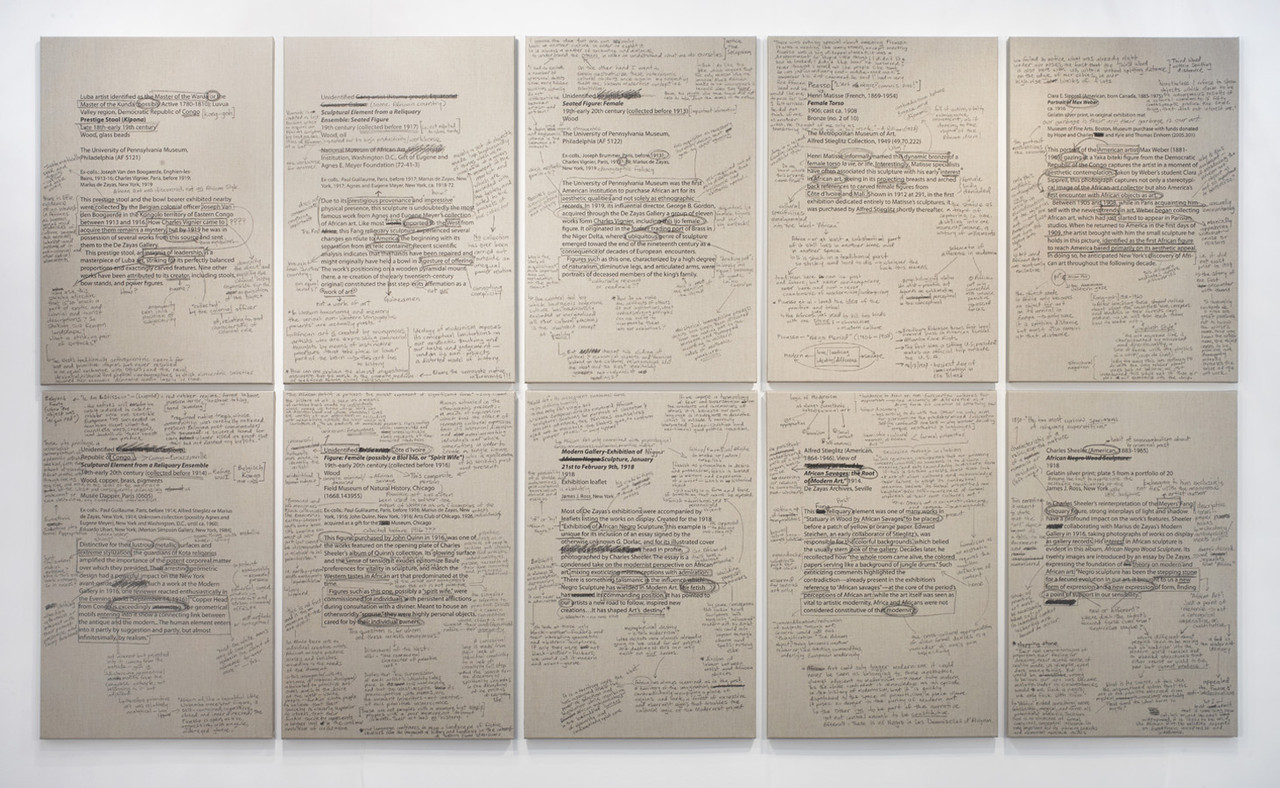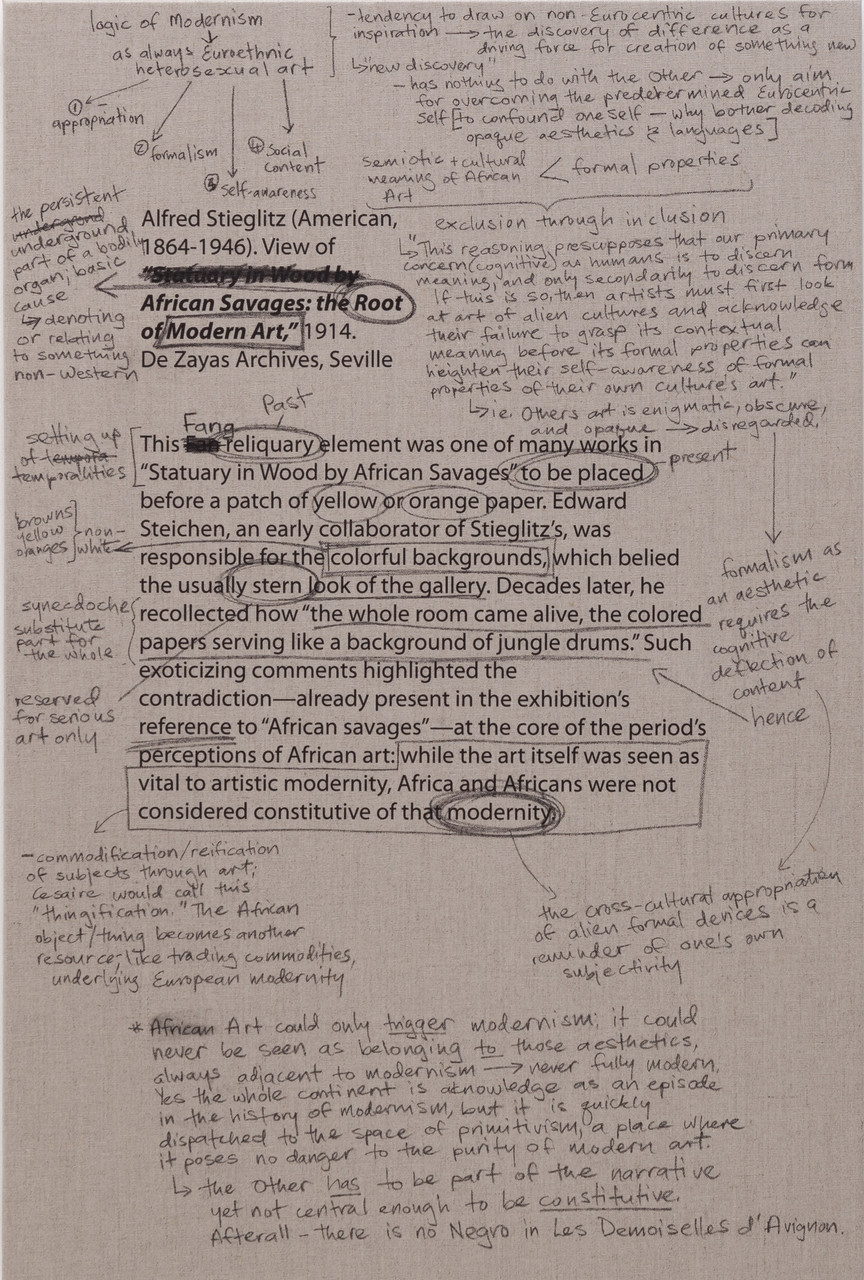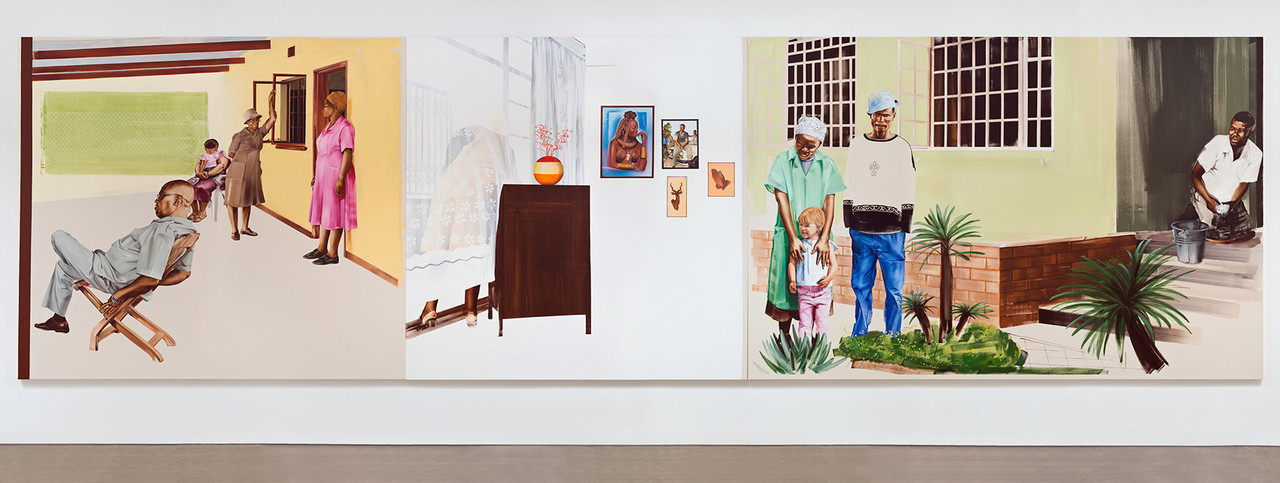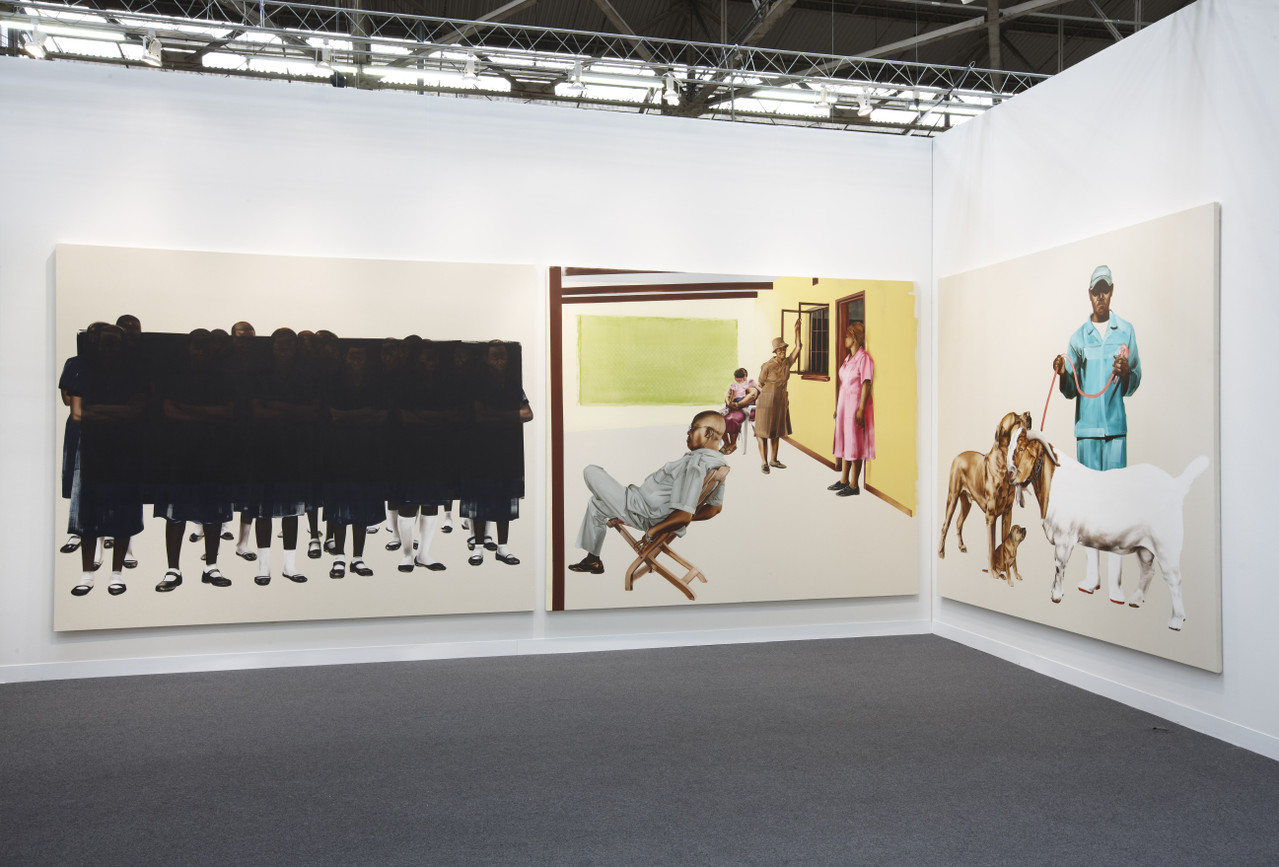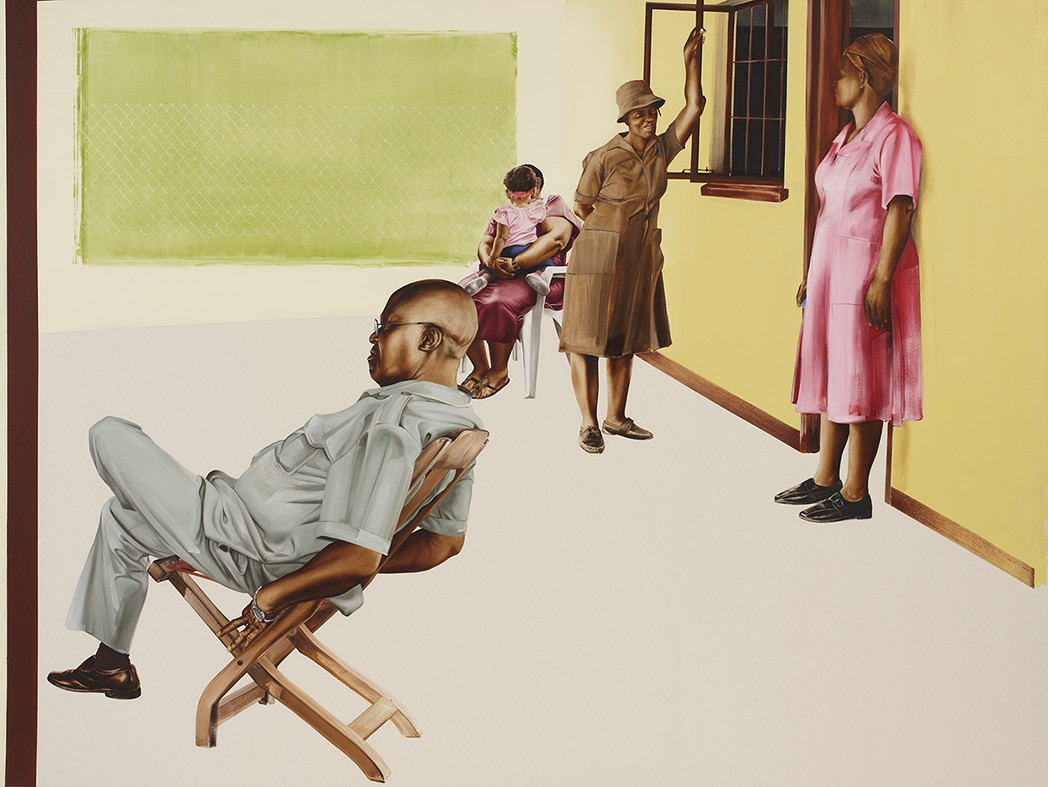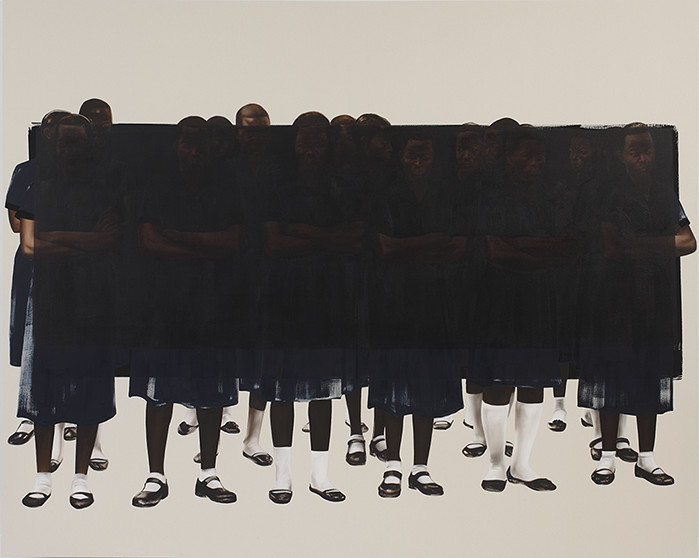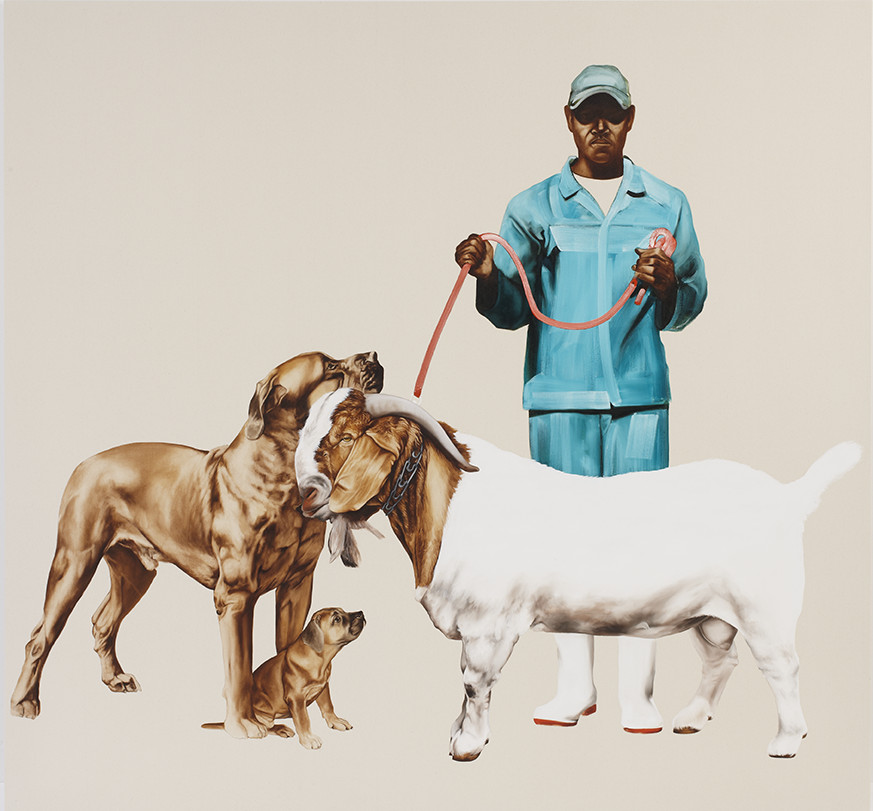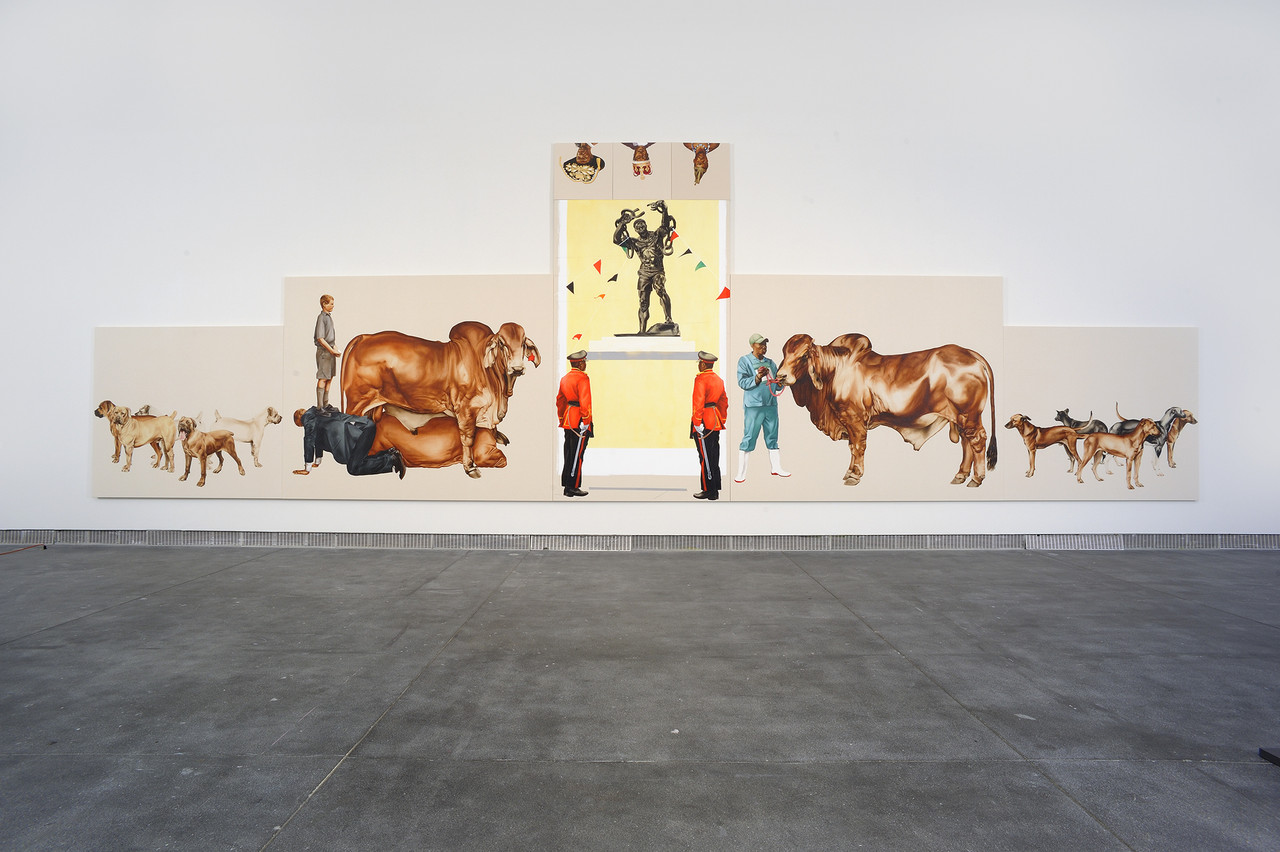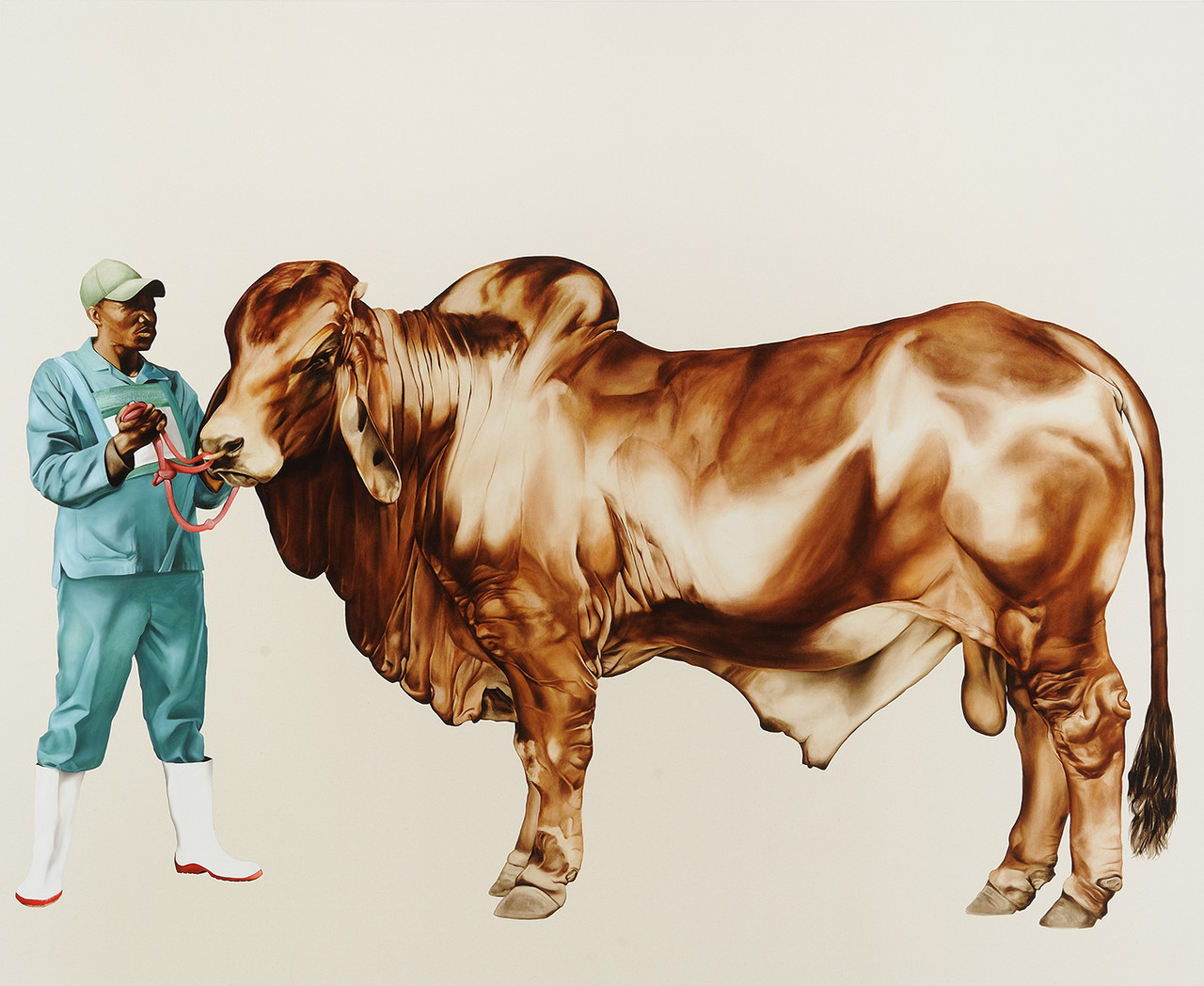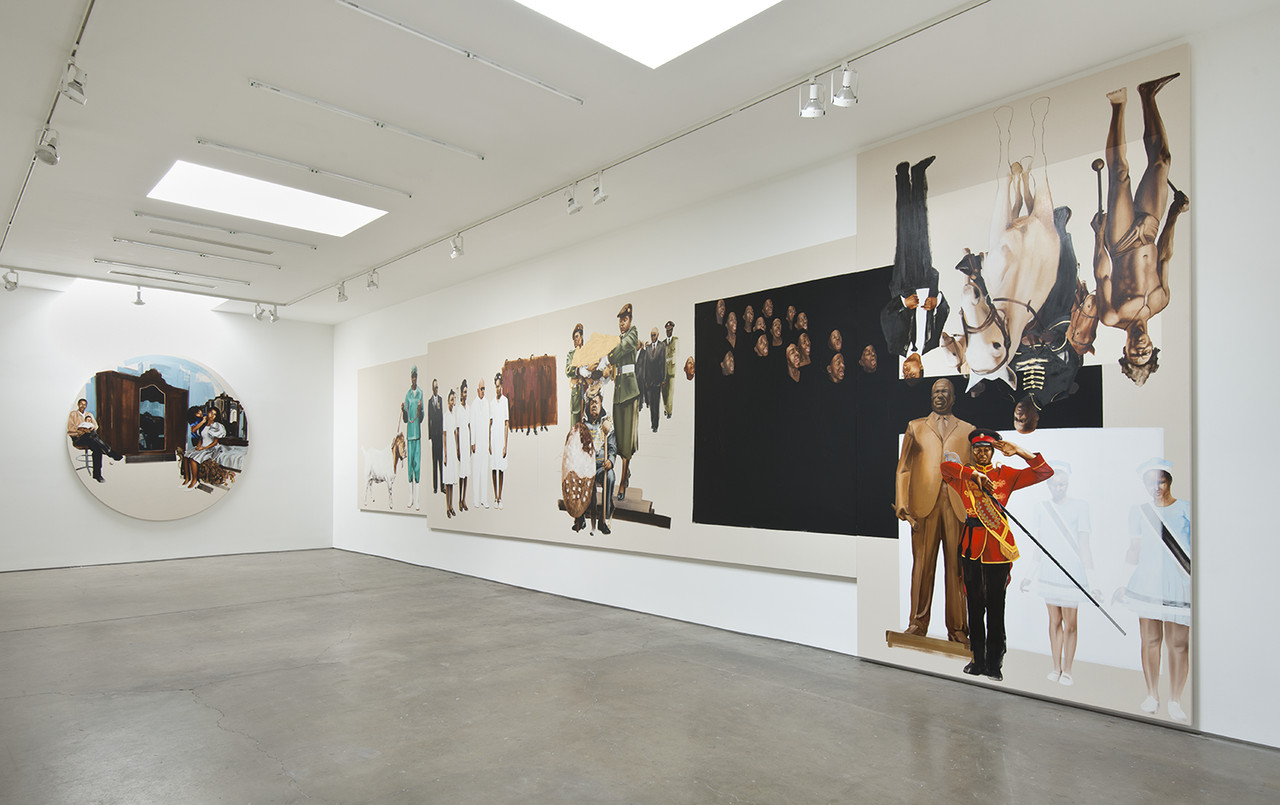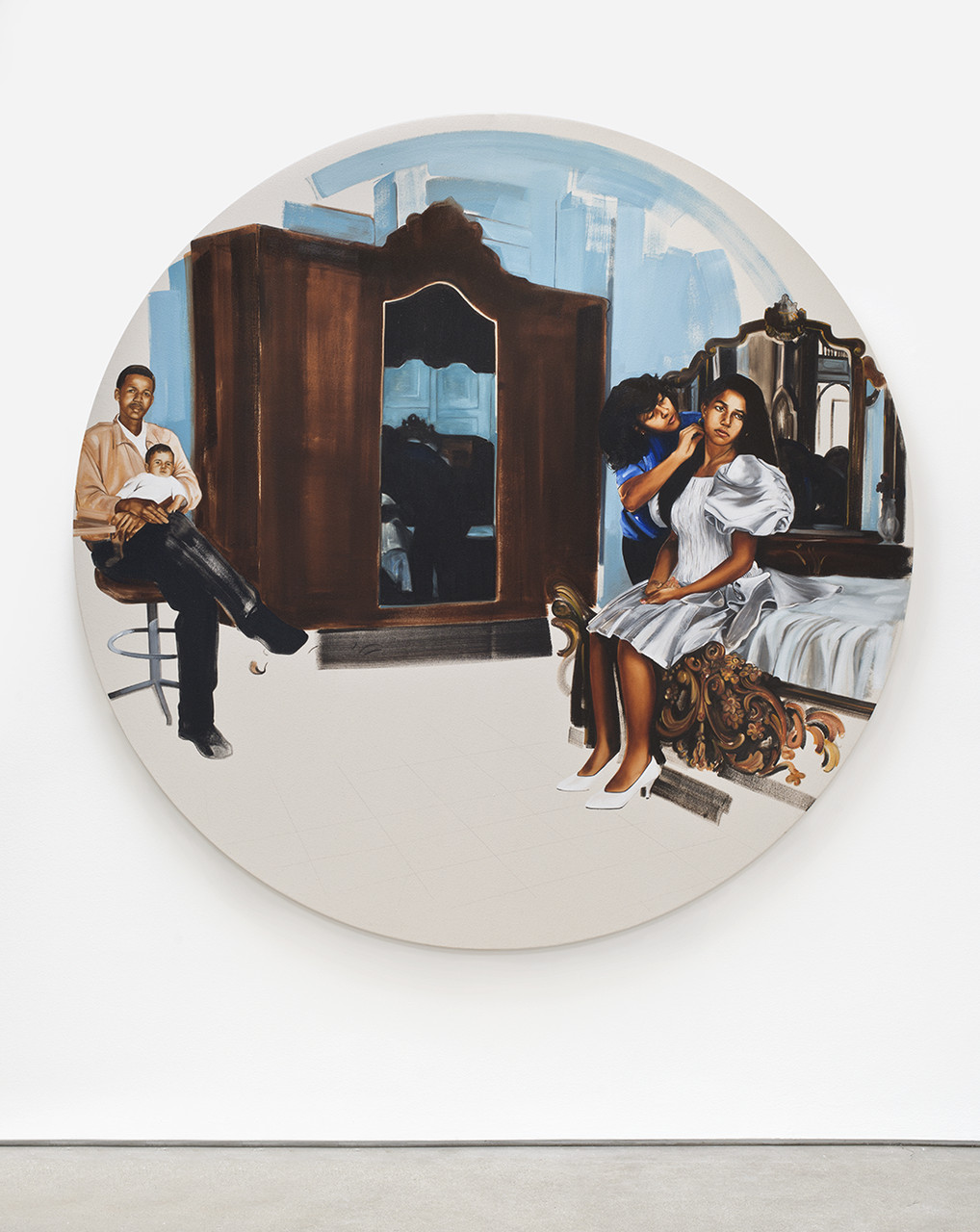What is my work about?
My work aims to interrogate narrative tropes and the fundamental models for the inscription and transmission of history along side established European notions of representation. I use the conventions of history painting and cinema to create large-scale installations, which are crafted through years of research that involves extensive travel, data collection, photography, and writing. Through Pax Kaffraria (2010-present), I propose that national identification is a vital force that grounds everything from our speech patterns to the tastes we prefer our tongues to enjoy. Hence nationalism is not entirely about sovereignty or nation-state politics, rather it is aligned with the texture of fantasy and desire, and the confluence of affect in language. Thus the work examines the rise and lure of globalization and trans-nationalism, and how these are continuously sabotaged by the great advance of nationalism and xenophobia in regions such as Germany, the United States, and South Africa.
Artist Statement
‘Pas de discours sans mettre en doute.’ – No speech without interrogation. This statement, made by a protestor during the Paris 1968 protests, succinctly demonstrates my approach to art because it reminds me to recognize two things: firstly that one must always assume the responsibility that accompanies any act of representation. Secondly, Art has everything to do with the use, form, and history of language, and that any language (textual/phonic/image) is always a dialogic system that lacks neutrality. As equally important, language is always material – and this materiality has meaning within history. It was through Max Beckmann, Kathe Kollwitz, and Otto Dix that I entered art and painting, and consequently understood what it meant to occupy the position of the artist.
I began working on Pax Afrikaner (2008-2011) and Pax Kaffraria (2010- 2014) following the abrupt and violent xenophobic attacks that occurred in South Africa starting in 2008. The attacks, I felt, implicated my positionality as someone from the region and invested in its histories, politics, and cultures. This implication came with substantial consequences regarding the ways in which I understood the discursive foundations that informed my daily-lived experiences both in Botswana and the U.S. Both the explosive xenophobia and violent nationalistic rejection of black foreigners mainly from neighbouring countries were puzzling given the close geographic and cultural proximity of South Africa to these countries. These attacks also unjustly negated the strong history of alliance between neighboring southern African countries against European colonial powers. My response to the events and shift in perspective was formed through an on-going engagement with Freudian and Lacanian psychoanalytic theory along side post-colonial studies – all used as a way of understanding the complex texture of both the xenophobia and what I believe to be one of the main causes: national identification in its peculiarity and material form (1). These theoretical models pushed me to focus on affect as opposed to the already established politics of the nation-state. In looking to psychoanalytic theoretical devices, my aim was to investigate how affect, or more precisely how cathexis operated in relation to language (langue) in general and the mother-tongue or “llanguage” (la langue)(2), and in turn the role that cathexis plays in the formation of an individual and how he identifies with a group. In short, such an approach to national identification which stresses a rigorous examination of the psyche, championed by theorists such as Yannis Stravakakis, Ernesto Laclau and Slavoj Zizek, proposes that nationalism is structured by the particular ways in which communities organize their enjoyment; and this identification is configured around a projected outsider who threatens this enjoyment.
In my projects, I examine questions of national identification, the function of the nation-state in post-independence southern Africa, and more importantly the effect that representation along side the legitimation of specific narratives has on the epistemological grounding of the daily-lived experiences of citizens in the region.
Pax Kaffraria (2010-2014) is an eight-chapter project that takes Botswana, South Africa, Zambia, and Zimbabwe as case studies, and attempts to ask important questions around the issues of national identification, colonial history, globalization, trans-nationality, whiteness, African-ness, and post-colonial aesthetics. Pax Kaffraria, is a conflation of two terms. The word “pax”, taken from the original phrase: ‘we Romans have purchased the pax Romana with our blood’, highlights the essence of institutionalized, enforced ‘peace’ at the height of the Roman Empire. ‘Pax Romana’, contrary to conventional belief is not about peace, it is about nationalism; it is precisely about the bond between blood and soil that undergirds nationalist projects and certain understanding of “peace.” “Kaffraria” is a term that was first used by the British in the eighteenth century to establish “British Kaffraria”: a subordinate administrative entity that was primarily inhabited by the Xhosa. More precisely, ‘kaffraria’ is a British adaptation of the word ‘kaffir’, which is derived from Arabic but was coopted by the Dutch or Boer in South Africa, and used as the equivalent of the derogatory term ‘nigger’. Pax Kaffraria then is a forcefully made appellation that is chiefly historical and mythical.
Although my work falls within the convention of history painting, I borrow from cinematic techniques in order to problematize the genre of (history) painting. Examples of this are evident in Pax Kaffraria, wherein the installations of thirty six large paintings were constructed to mimic the film strip; strategically use ‘cinematic’ scale; privilege peripheral vision as opposed to frontal vision; utilize cinematic shots (pan/medium-long shots); as well as use ‘the pause’ (used in film as a moment of self-reflexivity) – which in my work is signified by the use of negative space; and last but not least, the use of inter-titles to frame the chapters and project as a whole. Nationalism, I propose, is not entirely about territorial autonomy or sovereignty, or politics of the nation-state, rather it is aligned with the texture of fantasy and desire, and the confluence of affect in language. Although these speculations do not strictly follow indentitarianism, they propose that fantasy, desire and enjoyment (jouissance) are central to how a community organizes its enjoyment and how the meaning in rituals, objects, and language is bound to a specific piece of dirt.
Similar to my engagement with representation through history painting, the textbased installations offer further consideration of the normative models for the inscription and transmission of history. Modern Art: The Root of African Savages Meleko Mokgosi 3 (2012 – present) and Walls of Casbah (2009 – 2013) use appropriated wall labels from two exhibitions that deal in one way or another with African art. Both projects involve rigorous research of both the exhibition (installation and design) in addition to the objects in the exhibition. Here I address the problematic reinscription of colonial discourses with attempts at making critical interventions in the didactics that structure the way the public understands works of art in the museum setting, systematically working-through the power dynamics and cultural biases that underpin these presumably neutral, educational descriptors. In Modern Art: The Root of African Savages (2012 – present), I use the deeply problematic exhibition African Art, New York, and the Avant-Garde (The Metropolitan Museum of Art, New York, 2012); in another, the exhibition Walls of Algiers: Narratives of the City (Getty Center, 2009). Both exhibitions create narratives of inclusion that sublimate African art and Africa itself into a Western modernist project. My commentary on these labels is in turn personal and analytical, trying to insert an individual voice to counter these institutional constructions and legitimation of history.
Footnotes
(1) Major psychonanalytic texts that were an important frame of reference include Freud’s Group psychology and the Analysis of the Ego, Ecrits and The Four Fundamental Concepts of Psychoanalysis by Jacques Lacan, Yanis Stravakakis’ The Lacanian Left, Slavoj Zizek’s Tarrying with the Negative: Kant, Hegel, and the Critique of Ideology, as well as Michael Lewis’ book, Derrida and Lacan: Another Writing.
(2) Lalangue, which Jacques Lacan introduces in Seminar XX, is a combination of the word language and its definite article – in French; thus creating something unique to the language it is spoken in. For this reason, Lacan defines lalangue as the mother-tongue: the first language that we learn before we even learn how to make sense of things. Before we are able to rationalize through a reality principle – we operate through this first tongue.
CV
Education
2008-2011
University of California in Los Angeles, Los Angeles, CA
Master of Fine Art: Interdisciplinary Studio Program
2009
UCLA Certificate in Experimental Critical Theory [pilot]
2003 -‐ 2007
Williams College, Williamstown, MA
Bachelor of Arts: Studio Art
2005 -‐ 2006
Slade School Of Fine Art, London, England
One year Affiliate Independent Study painting program Artist Residency and Studio Programs Studio Museum in Harlem, New York, NY 2011 -‐ 2012
Artist in Residence
2007 -‐ 2008
Whitney Museum of American Art, New York, NY
Independent Study Program (Studio)
Exhibitions
2014
Pax Kaffraria, Honor Fraser, Los Angeles, CA
Armory 2014, New York, NY
12th Biennale de Lyon, Lyon, France
2013
Yerba Buena Center for the Arts in San Francisco, CA Migrating Identities
Nolan Judin, Berlin, Germany The Beautyful Ones,
Armory 2013, New York, NY
2012
Hammer Museum, Los Angeles, CA Made in LA
Studio Museum in Harlem, New York, NY Artist in Residence exhibition;
Beacon Arts Gallery, Los Angeles, CA Capital Offense: The End(s) of Capitalism
2011
Studio Museum in Harlem, New York, NY The Bearden Project
The Hudson Valley Center for Contemporary Art Museum Look III
University of California, Los Angeles, New Wight Gallery MFA Graduate Exhibition
2010
Vox Populi, Philadelphia, PA Quadruple-‐Consciousness
University of California, Los Angeles, New Wight Gallery MFA Graduate Group Exhibition
University of California, Long Beach GLAMFA
2009
Without, New Wight Gallery, Los Angeles, CA
Narratives of Now, Los Angeles, CA Conference presentation hosted by African Activist Association (UCLA)
Work Gallery, New York, NY Without
Williams Club Gallery, New York, NY Solo Exhibition
2008
Botswana National Gallery and Thapong Workshop, Gaborone, Botswana Four Continents, group exhibition
National Library of Cameroon, Yaounde, Cameroon, AmericAura Group Exhibition
Pool of Possibilities: Mapping Currents for the 3rd Guangzhou Triennial
Artists Archive Whitney Museum ISP New York City, NY
End of year group exhibition
2007
Hampden Gallery, University of Amherst, MA AmericAura Group Exhibition
Augusta Savage Gallery, University of Massachusetts Amherst, MA, AmericAura Group Exhibition
Williams College Museum of Art, Williamstown, MA Graduating Exhibition: Nineteen
Berkshire Art Association, Pittsfield, MA
Fellowship Exhibition at The Lichtenstein Gallery
Charles P. Russell Gallery, Deerfield Academy, Deerfield, MA, Solo Exhibition: In Transit
2006
Wilde Gallery, Spencer Art Studio, Williamstown, MA, Senior Art Major’s Exhibition
2005
Woburn Square Studios, London, England Slade School of Fine Art Student Exhibition
Berkshire Art Association, Pittsfield, MA Fellowship Exhibition
2004
Wilde Gallery, Spencer Studio, Williamstown, MA Independent Study Exhibition
Contemporary Artist Center, North Adams, MA Berkshire Biennial
2003
Maitisong, Gaborone, Botswana Solo Exhibition
2002
National Gallery, Gaborone, Botswana Thapong International Artists Workshop Group Exhibition
2001
Alliance Française Gallery, Gaborone, Botswana Group Exhibition
2000
National Gallery, Gaborone, Botswana Group Exhibition
Awards and Grants Received
The Joan Mitchell Foundation Painters Grant, 2013
Jarl and Pamela Mohn Award, 2012
Hubbard Hutchinson Memorial Fellowship, 2007
Berkshire Art Association Fellowship, 2007
Florence E. and Horace L. Mayer Scholarship, December 2006
Mary and Nathaniel Lawrence Memorial Travel Fellowship, 2006
Berkshire Art Association Fellowship, 2004
Public Installations
Eli Broad Art Center, Los Angeles, CA. 2008-‐Present
Williams College Theatre, Williamstown, MA. 2006-‐Present
The Hudson Valley Center for Contemporary Art 2011-‐Present
Presentations/Invitations
Faculty Painting Mentor, 2014 Vermont College of Fine Arts, Montpelier, VT
Artist Talk (Migrating Identities), 2013 Yerba Buena Centre for Arts, San Francisco, CA
Painting Expanded (Conference), 2013 California College of the Arts, San Francisco, CA
Visiting Faculty, January 2012 Vermont College of Fine Arts, Montpelier, VT
Artist Lecture, 2012 Hunter College, New York, NY
Publications
Hatcher, Alison. “Meleko Mokgosi.” Art for Rollins. 2013
Gaines, Malik. “Meleko Mokgosi.” Made in L.A. 2012,
May Ramoran, Edwin. “Meleko Mokgosi: Mise-‐en-‐scène.” 2012
Jessica Lott, Samir S. Patel. The Bearden Project. 2012 Bibliography 2014
Ollman, Leah. “Meleko Mokgosi’s Work Flames with Purpose and Pointed History.” Los Angeles Times, May 9
Tribinevicius, Medein, “An Interrogation of Post-‐colonial History.” Mail and Guardian, June 27
Farago, Jason. “Meleko Mokgosi.” Artforum critics picks, May 27
Markopoulos, Leigh. “Painting Expanded.” Art Practical, April 15 Arts Obserever. “Meleko Mokgosi’s Multi-‐Part Meditation on Post-‐Colonialism.” June 3 2013
Saltz, Jerry. “20 Things I Really Liked at the Art Fairs.” New York Magazine, March 16
Ossei-‐Mensah, Larry. “Making a Scene.” Arise Magazine, April 23, 2013
Goldestein, Andrew. “9 Highlights from the Armory Show.” Artspace, February 15 2012
Lipschutz, Yael. “Meleko Mokgosi’s Existentialism.” Art in America, June 2012 “24 Artists to Watch: Meleko Mokgosi.” Modern Painters, December
Griffin, Jonathan. “Made in L.A.” Frieze, September 4
Finkel, Jori. “Hammer Museum’s $100,000 Mohn Award goes to Meleko Mokgosi.” Los Angeles Times, August 16
Clothier, Peter. “Made in LA.” Huffington Post, July 18
Kennedy, Randy. “Hammer Museum Awards Its Crowdsourced Art Prize.” The New York Times, August 16
Elliott, Bobby. “Primary Sources, The Studio Museum’s Annual Artist in Residence Exhibition.” Huffington Post, June 17
Stoilas, Helen. “Work dealing with African resistance wins $100,000 prize.” The Art Newspaper, August 16
Shatkin, Elina. “Meleko Mokgosi Wins $100,000 Made in L.A. Prize.” Los Angeles Magazine, August 16 “Exploring Art ‘Made in L.A. 2012’.” Our Weekly, August 23
Pincus-Roth, Zachary. “Meleko Mokgosi Wins Hammer Museum’s Mohn Award.” LAWeekly, August 16
Sutton, Benjamin. “Painter Meleko Mokgosi Wins Hammer Museum’s Inaugural ‘American Idol’ – Style Mohn Award.” Artinfo, August 16
Boucher, Brian. “Meleko Mokgosi Wins ‘Made in LA’ Mohn Award.” Art in America, August 16
Cascone, Sarah. “Finalists for Hammer/LAXART’s Inaugural Mohn Prize Announced.” Art in America, June 28
Lipschultz, Yael. “Meleko Mokgosi’s Existentialism.” Art in America, June 29 “Meleko Mokgosi to Receive Hammer Museum’s Mohn Award.” ArtDaily, September 4 2011
John, Arit. “Graduate Students to Exhibit their Artwork at the ART MFA Exhibition #1.” Daily Bruin, March 3 2009
Lebowitz, Aniuli. “Without at WORK Gallery.” Artcat, April 3

